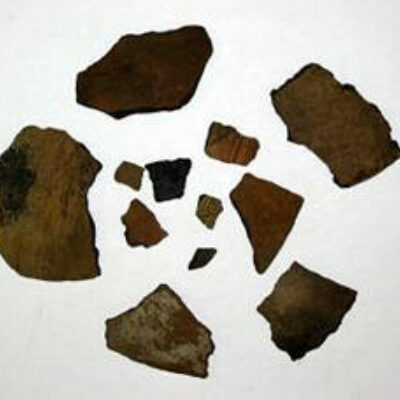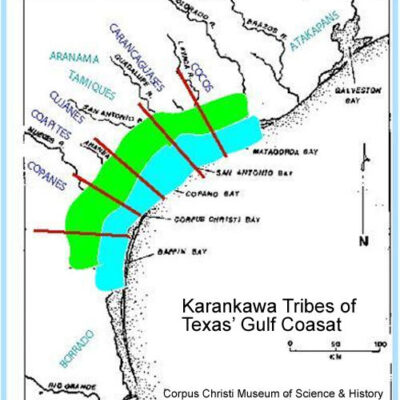During the month of June, an assortment of pottery shards and projectile points from Galveston’s earliest inhabitants – the Karankawa Indians – was on display. This collection of Native American artifacts was donated by Dr. J. O. Dyer, a local physician and historian, between 1916 and 1926.

The term “Karankawa” refers to a now-extinct group of Native American peoples who resided along the Texas Gulf Coast from Galveston Bay to Corpus Christi Bay. Though they shared a common language and way of life, there were actually three distinct tribes of Karankawa Indians: the Coaques, the Copanes, and the Carancaquacas.
Archaeological evidence shows that the Karankawas were nomadic hunter-gatherers who lived in round thatch huts, or wigwams. They traveled in bands of thirty to forty people led by a chief, and their principal mode of transportation was the dugout canoe.

During the winter, the Karankawas would set up camps around the coastal bays. They subsisted on fish, shellfish, and turtles. In warmer months, the tribes would move inland to hunt deer and bison and to gather berries, nuts, and roots. Karankawa men were expert hunters and fisherman. The Karankawas crafted pottery, baskets, and weapons, including the long bow. The bow and arrow was their primary weapon for hunting and warfare.
Karankawa men were reported to have been unusually tall and heavily tattooed. They pierced various parts of their faces and bodies. Karankawa women also tattooed their skin and wore body paint. Their clothing was fashioned from animal skins or Spanish moss.
While many accounts allege that the Karankawas held elaborate cannibalistic ceremonies, this claim has been disputed by some scholars. While ritual flesh-eating of one’s enemies was not uncommon among Indian tribes in Texas and Louisiana, there is not sufficient evidence to suggest that the Karankawas were among those groups which practiced cannibalism.

The Karankawa Indians first appeared on the historical record in 1528. Alvar Nunez Cabeza de Vaca, a Spanish explorer, was among the shipwrecked survivors from the Panfilo de Narvaez expedition. These men landed on a small island west of Galveston that was inhabited by Karankawas. Cabeza de Vaca lived among the native peoples for several years, and much of what we know about the Karankawas comes from his written accounts.
In 1685, Rene Robert Cavalier, Sieur de la Salle, led a French expedition along the Texas Coast. Near Matagorda Bay, he established a colony for France and named it Fort St. Louis. Soon after, the Karankawas attacked the settlers, killing all but several children whom they took captive. These children were later rescued by Spanish explorers in the early 1690s, and their accounts of life among the Karankawas provide a great deal of insight into the customs and culture of these people.
France and Spain continued sending explorers along the Texas Coast, and by the early 18th century, the Spanish had organized a number of missions to Christianize the native tribes and to make them loyal subjects. The missionary system created hostility between Spaniards and Indians, and conflicts often erupted. By the early 1800s, however, epidemic diseases introduced by the Europeans had greatly reduced the population of native peoples in the New World. The Karankawas also suffered from settlers invading their lands and competing for resources.

The Karankawas in Galveston faced a detrimental blow after a confrontation with Jean Lafitte’s commune at Campeche in 1819. After Lafitte’s men kidnapped a young Karankawa woman, 300 warriors from her tribe attacked the privateer’s fort. Although they were far outnumbered by the Karankawas, the men at the commune were armed with two cannons. The bows and arrows of the Karankawas were no match for this deadly arsenal.
After Mexico gained independence from Spain in 1821, Anglo-Americans were encouraged to immigrate to Texas, then a sparsely populated province. Colonists were frequently attacked by the Karankawas, and efforts were made to “exterminate” the native peoples. During the 1840s, only a few scattered tribes of Karankawa Indians remained along the Texas coast. Disease, colonization, and genocidal warfare proved to be a lethal combination. By 1858, the Karankawas were considered an extinct group of people.